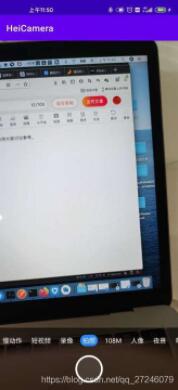android camera滑动,Android怎么实现小米相机底部滑动指示器
Android怎么实现小米相机底部滑动指示器发布时间:2021-04-15 14:39:38来源:亿速云阅读:94作者:小新这篇文章给大家分享的是有关Android怎么实现小米相机底部滑动指示器的内容。小编觉得挺实用的,因此分享给大家做个参考,一起跟随小编过来看看吧。先上一张图看下效果:主要实现功能有:1.支持左右滑动,每次滑动一个tab2.支持tab点击,直接跳到对应tab3.选中的tab一直处
Android怎么实现小米相机底部滑动指示器
发布时间:2021-04-15 14:39:38
来源:亿速云
阅读:94
作者:小新
这篇文章给大家分享的是有关Android怎么实现小米相机底部滑动指示器的内容。小编觉得挺实用的,因此分享给大家做个参考,一起跟随小编过来看看吧。
先上一张图看下效果:

主要实现功能有:
1.支持左右滑动,每次滑动一个tab
2.支持tab点击,直接跳到对应tab
3.选中的tab一直处于居中位置
4.支持部分UI自定义(大家可根据需要自己改动)
5.tab点击回调
6.内置Tab接口,放入的内容需要实现Tab接口
7.设置预选中tabpublic class CameraIndicator extends LinearLayout {
// 当前选中的位置索引
private int currentIndex;
//tabs集合
private Tab[] tabs;
// 利用Scroller类实现最终的滑动效果
public Scroller mScroller;
//滑动执行时间(ms)
private int mDuration = 300;
//选中text的颜色
private int selectedTextColor = 0xffffffff;
//未选中的text的颜色
private int normalTextColor = 0xffffffff;
//选中的text的背景
private Drawable selectedTextBackgroundDrawable;
private int selectedTextBackgroundColor;
private int selectedTextBackgroundResources;
//是否正在滑动
private boolean isScrolling = false;
private int onLayoutCount = 0;
public CameraIndicator(Context context) {
this(context, null);
}
public CameraIndicator(Context context, @Nullable AttributeSet attrs) {
this(context, attrs, 0);
}
public CameraIndicator(Context context, @Nullable AttributeSet attrs, int defStyleAttr) {
super(context, attrs, defStyleAttr);
mScroller = new Scroller(context);
}
@Override
protected void onMeasure(int widthMeasureSpec, int heightMeasureSpec) {
super.onMeasure(widthMeasureSpec, heightMeasureSpec);
int widthMode = MeasureSpec.getMode(widthMeasureSpec);
int widthSize = MeasureSpec.getSize(widthMeasureSpec);
int heightMode = MeasureSpec.getMode(heightMeasureSpec);
int heightSize = MeasureSpec.getSize(heightMeasureSpec);
//测量所有子元素
measureChildren(widthMeasureSpec, heightMeasureSpec);
//处理wrap_content的情况
int width = 0;
int height = 0;
if (getChildCount() == 0) {
setMeasuredDimension(0, 0);
} else if (widthMode == MeasureSpec.AT_MOST && heightMode == MeasureSpec.AT_MOST) {
for (int i = 0; i
View child = getChildAt(i);
width += child.getMeasuredWidth();
height = Math.max(height, child.getMeasuredHeight());
}
setMeasuredDimension(width, height);
} else if (widthMode == MeasureSpec.AT_MOST) {
for (int i = 0; i
View child = getChildAt(i);
width += child.getMeasuredWidth();
}
setMeasuredDimension(width, heightSize);
} else if (heightMode == MeasureSpec.AT_MOST) {
for (int i = 0; i
View child = getChildAt(i);
height = Math.max(height, child.getMeasuredHeight());
}
setMeasuredDimension(widthSize, height);
} else {
//如果自定义ViewGroup之初就已确认该ViewGroup宽高都是match_parent,那么直接设置即可
setMeasuredDimension(widthSize, heightSize);
}
}
@Override
protected void onLayout(boolean changed, int l, int t, int r, int b) {
//给选中text的添加背景会多次进入onLayout,会导致位置有问题,暂未解决
if (onLayoutCount > 0) {
return;
}
onLayoutCount++;
int counts = getChildCount();
int childLeft = 0;
int childRight = 0;
int childTop = 0;
int childBottom = 0;
//居中显示
int widthOffset = 0;
//计算最左边的子view距离中心的距离
for (int i = 0; i
View childView = getChildAt(i);
widthOffset += childView.getMeasuredWidth() + getMargins(childView).get(0)+getMargins(childView).get(2);
}
//计算出每个子view的位置
for (int i = 0; i
View childView = getChildAt(i);
childView.setOnClickListener(v -> moveTo(v));
if (i != 0) {
View preView = getChildAt(i - 1);
childLeft = preView.getRight() +getMargins(preView).get(2)+ getMargins(childView).get(0);
} else {
childLeft = (getWidth() - getChildAt(currentIndex).getMeasuredWidth()) / 2 - widthOffset;
}
childRight = childLeft + childView.getMeasuredWidth();
childTop = (getHeight() - childView.getMeasuredHeight()) / 2;
childBottom = (getHeight() + childView.getMeasuredHeight()) / 2;
childView.layout(childLeft, childTop, childRight, childBottom);
}
TextView indexText = (TextView) getChildAt(currentIndex);
changeSelectedUIState(indexText);
}
private List getMargins(View view) {
LayoutParams params = (LayoutParams) view.getLayoutParams();
List listMargin = new ArrayList();
listMargin.add(params.leftMargin);
listMargin.add(params.topMargin);
listMargin.add(params.rightMargin);
listMargin.add(params.bottomMargin);
return listMargin;
}
@Override
public void computeScroll() {
if (mScroller.computeScrollOffset()) {
// 滑动未结束,内部使用scrollTo方法完成实际滑动
scrollTo(mScroller.getCurrX(), mScroller.getCurrY());
invalidate();
} else {
//滑动完成
isScrolling = false;
if (listener != null) {
listener.onChange(currentIndex,tabs[currentIndex]);
}
}
super.computeScroll();
}
/**
* 改变选中TextView的颜色
*
* @param currentIndex 滑动之前选中的那个
* @param nextIndex 滑动之后选中的那个
*/
public final void scrollToNext(int currentIndex, int nextIndex) {
TextView selectedText = (TextView) getChildAt(currentIndex);
if (selectedText != null) {
selectedText.setTextColor(normalTextColor);
selectedText.setBackground(null);
}
selectedText = (TextView) getChildAt(nextIndex);
if (selectedText != null) {
changeSelectedUIState(selectedText);
}
}
private void changeSelectedUIState(TextView view) {
view.setTextColor(selectedTextColor);
if (selectedTextBackgroundDrawable != null) {
view.setBackground(selectedTextBackgroundDrawable);
}
if (selectedTextBackgroundColor != 0) {
view.setBackgroundColor(selectedTextBackgroundColor);
}
if (selectedTextBackgroundResources != 0) {
view.setBackgroundResource(selectedTextBackgroundResources);
}
}
/**
* 向右滑一个
*/
public void moveToRight() {
moveTo(getChildAt(currentIndex - 1));
}
/**
* 向左滑一个
*/
public void moveToLeft() {
moveTo(getChildAt(currentIndex + 1));
}
/**
* 滑到目标view
*
* @param view 目标view
*/
private void moveTo(View view) {
for (int i = 0; i
if (view == getChildAt(i)) {
if (i == currentIndex) {
//不移动
break;
} else if (i
//向右移
if (isScrolling) {
return;
}
isScrolling = true;
int dx = getChildAt(currentIndex).getLeft() - view.getLeft() + (getChildAt(currentIndex).getMeasuredWidth() - view.getMeasuredWidth()) / 2;
//这里使用scroll会使滑动更平滑不卡顿,scroll会根据起点、终点及时间计算出每次滑动的距离,其内部有一个插值器
mScroller.startScroll(getScrollX(), 0, -dx, 0, mDuration);
scrollToNext(currentIndex, i);
setCurrentIndex(i);
invalidate();
} else if (i > currentIndex) {
//向左移
if (isScrolling) {
return;
}
isScrolling = true;
int dx = view.getLeft() - getChildAt(currentIndex).getLeft() + (view.getMeasuredWidth() - getChildAt(currentIndex).getMeasuredWidth()) / 2;
mScroller.startScroll(getScrollX(), 0, dx, 0, mDuration);
scrollToNext(currentIndex, i);
setCurrentIndex(i);
invalidate();
}
}
}
}
/**
* 设置tabs
*
* @param tabs
*/
public void setTabs(Tab... tabs) {
this.tabs = tabs;
//暂时不通过layout布局添加textview
if (getChildCount()>0){
removeAllViews();
}
for (Tab tab : tabs) {
TextView textView = new TextView(getContext());
textView.setText(tab.getText());
textView.setTextSize(14);
textView.setTextColor(selectedTextColor);
textView.setPadding(dp2px(getContext(),5), dp2px(getContext(),2), dp2px(getContext(),5),dp2px(getContext(),2));
LayoutParams layoutParams= new LayoutParams(LayoutParams.WRAP_CONTENT,LayoutParams.WRAP_CONTENT);
layoutParams.rightMargin=dp2px(getContext(),2.5f);
layoutParams.leftMargin=dp2px(getContext(),2.5f);
textView.setLayoutParams(layoutParams);
addView(textView);
}
}
public int getCurrentIndex() {
return currentIndex;
}
//设置默认选中第几个
public void setCurrentIndex(int currentIndex) {
this.currentIndex = currentIndex;
}
//设置滑动时间
public void setDuration(int mDuration) {
this.mDuration = mDuration;
}
public void setSelectedTextColor(int selectedTextColor) {
this.selectedTextColor = selectedTextColor;
}
public void setNormalTextColor(int normalTextColor) {
this.normalTextColor = normalTextColor;
}
public void setSelectedTextBackgroundDrawable(Drawable selectedTextBackgroundDrawable) {
this.selectedTextBackgroundDrawable = selectedTextBackgroundDrawable;
}
public void setSelectedTextBackgroundColor(int selectedTextBackgroundColor) {
this.selectedTextBackgroundColor = selectedTextBackgroundColor;
}
public void setSelectedTextBackgroundResources(int selectedTextBackgroundResources) {
this.selectedTextBackgroundResources = selectedTextBackgroundResources;
}
public interface OnSelectedChangedListener {
void onChange(int index, Tab tag);
}
private OnSelectedChangedListener listener;
public void setOnSelectedChangedListener(OnSelectedChangedListener listener) {
if (listener != null) {
this.listener = listener;
}
}
private int dp2px(Context context, float dpValue) {
DisplayMetrics metrics = context.getResources().getDisplayMetrics();
return (int) (metrics.density * dpValue + 0.5F);
}
public interface Tab{
String getText();
}
private float startX = 0f;
@Override
public boolean onTouchEvent(MotionEvent event) {
if (event.getAction() == MotionEvent.ACTION_DOWN) {
startX = event.getX();
}
if (event.getAction() == MotionEvent.ACTION_UP) {
float endX = event.getX();
//向左滑条件
if (endX - startX > 50 && currentIndex > 0) {
moveToRight();
}
if (startX - endX > 50 && currentIndex
moveToLeft();
}
}
return true;
}
@Override
public boolean onInterceptTouchEvent(MotionEvent event) {
if (event.getAction() == MotionEvent.ACTION_DOWN) {
startX = event.getX();
}
if (event.getAction() == MotionEvent.ACTION_UP) {
float endX = event.getX();
//向左滑条件
if (Math.abs(startX-endX)>50){
onTouchEvent(event);
}
}
return super.onInterceptTouchEvent(event);
}
}
在Activity或fragment中使用private var tabs = listOf("慢动作", "短视频", "录像", "拍照", "108M", "人像", "夜景", "萌拍", "全景", "专业")
lateinit var imageAnalysis:ImageAnalysis
override fun initView() {
//实现了CameraIndicator.Tab的对象
val map = tabs.map {
CameraIndicator.Tab { it }
}?.toTypedArray() ?: arrayOf()
//将tab集合设置给cameraIndicator,(binding.cameraIndicator即xml布局里的控件)
binding.cameraIndicator.setTabs(*map)
//默认选中 拍照
binding.cameraIndicator.currentIndex = 3
//点击某个tab的回调
binding.cameraIndicator.setSelectedTextBackgroundResources(R.drawable.selected_text_bg)
binding.cameraIndicator.setOnSelectedChangedListener { index, tag ->
Toast.makeText(this,tag.text,Toast.LENGTH_SHORT).show()
}
}
感谢各位的阅读!关于“Android怎么实现小米相机底部滑动指示器”这篇文章就分享到这里了,希望以上内容可以对大家有一定的帮助,让大家可以学到更多知识,如果觉得文章不错,可以把它分享出去让更多的人看到吧!
更多推荐
 已为社区贡献1条内容
已为社区贡献1条内容









所有评论(0)